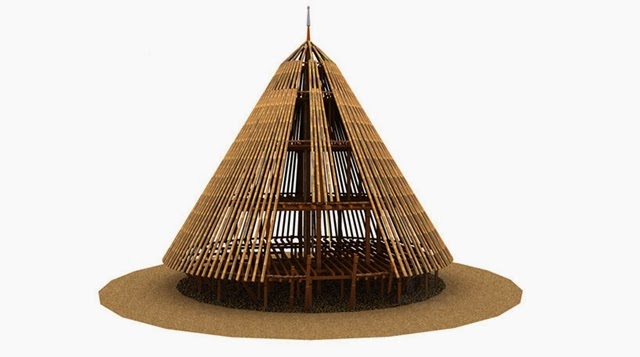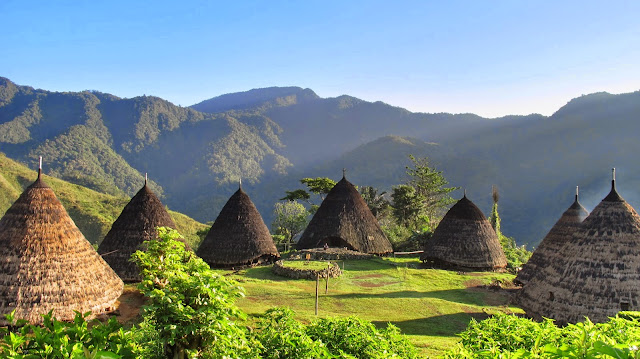Hi Hidden Paradise seeker meet me again...
Do you know where is Indonesia is? When You say Indonesia is Bali you are totally wrong, and you must check Hidden Paradise.If you already know about Indonesia let's get to the point!
This time I'll take a trip with you to The World Heritage of Waerebo which is located in Flores.
Before we go, this is our trip previously :
- Indonesia's Maldives
- The Dancing Blue Fire
- The 7 wonders of the world Borobudur Temple
- Last Dinosaurs on the earth
- Adventure in Mt. Bromo
Okay, let's go to Waerebo..
Is Waerebo didn't sound familiar? not just you, even the citizen in Indonesia don't know what is, or where is Waerebo? So, what is Waerebo? Waerebo is a Village, where is it? Just keep reading...
Before 2011, about 2000-2010, not many people know about Desa Waerebo(Waerebo Village), a rural village in Manggarai Flores, that really "must visit" destination when you visiting to Flores Island. Talk about Flores, Komodo Island is still be the iconic destination. Even when we ask to civilians who stay in Flores about this village, is still many civilians doesn't know about Desa Waerebo.
We can't ignored that advance of technology makes information going easier to get. Through social media, traveler who went there they publish their picture or story about how beatifull and welcoming is the village. They share the itinerary, how much does it cost, and information about access to get there. That's what make Desa Waerebo become famous until now.
 |
| Short history about Waerebo |
They continue their journey to North until they found place named Waraloka. Based on story the civilians in Waerebo, Empo Maro was move from village to another village, start from Waraloka,Waraloka Then move to Mangapa’ang, then move again to Todo, Popo, Liho, Mofo, Golo Ponto, Ndara, Golo Pando, Golo Damu, and finally settled permanently in Waerebo, where they lived and had descendants until now.
Waerebo become her last settle because her dream tel her that she must move to another place in East. and their descendants from Empo Maro keep preserve their village and their culture to the present. Like their local language "Neka hemong kuni agu kalo" mean " Waerebo is the land of birth, inheritance, and our home that will never be forgotten"
UNESCO rewarding Desa Waerebo an award of UNESCO Asia Pacific Award for Cultural Heritage Conservation on August 27, 2012. This award is the highest award given to those who commit to a cultural heritage conservation.
 |
| Hike to Waerebo |
WaeRebo has been supported to become the major culture tourism attraction in West Flores. Together with a team of Jakarta-based architects and the Indonesian government, the local community renovated four of their mbaru niang – or ‘drum houses’ in the Manggaraian language.
 |
| Cone-shaped Waerebo buildings |
When you visit Wae Rebo, you will not only see the authentic Manggaraian housing, but also get an opportunity to experience the daily life of the local people. Most of the people work in their gardens from early morning until dawn, busy with harvesting coffee and processing the beans. Even though weaving is not a major activity in Wae Rebo, you may encounter some women weaving traditional songket cloth. Visitors are welcome to spend the night in the mbaru niang, and to socialize and dine with the Wae Rebo community. You will sleep on a tikar, a woven mat made out of pandanus leaf, in the mbaru niang, and get a taste of how life used to be when the extended families still lived their lives under one roof.
 |
| All of 7 houses in Waerebo |
The entire Mbaru Niang has a different name, they are:
1. Tambour Niang
2. Niang Gena Mandok
3. Niang Gena Jekong (rebuilt in 2010)
4. Niang Gena Ndorom (rebuilt in 2009)
5. Niang Gena Keto
6. Niang Gena Jintam
7. Niang Gena Maro
 |
| Levels of Waerebo House |
The first floor is divided in 2 parts, Nolang and Lutur, with one door as the entrance and exit. Nolang is the private part of Mbaru Niang, that a place for the stove or firewood that is used for cooking and eating, as well as bedrooms for 6-8 families residing in. The rooms are arranged by the order of birth from each leader of the family. While Lutur is the zone used for public spaces and community activities.
Similar to the concept of the Compang became Central of all custom homes in this village and became part of the most sacred, the most sacred place on the first floor which is located in the middle of the House is called the "hunchback". In front of the Poles this is usually Customary Chair Hunchback would sit in every community meeting Waerebo.
How to get there?
There are several options for getting to Wae Rebo:
Car or motorbike from Ruteng:
Start the 2.5 - 3 hour drive by heading south towards Golo Lusang. After having passed Pong Nggeok village, you will cross Wae Mese bridge. Go ahead to Narang village, followed by Nanga Ramut village, and you will end up in Dintor. From this small fishing village you can see the beautiful Mules Island. The road to the north brings you to Kombo – Wae Rebo’s twin village – and finally to Denge village, which is the starting point for the hike to Wae Rebo.Truck (oto kayu) from Ruteng:
From the Mena Bus Terminal, the truck route will take you across the villages of Cancar, Pela, Todo, and Dintor before you finally reach Denge Village.The oto kayu usually departs from the terminal in the afternoon. The trip takes about 3 – 3 1/2 hours. If you want to go back from Denge to Ruteng, you will have to wake up early as the bis kayu departs from Denge at 5.30am.
Boat:
The boat trip is a good option if you start the trip from Labuan Bajo. Head south to the coastal village of Nangalili. Once there, you have to rent a boat (about Rp 400,000) to take you to Dintor. As there is no regular boat schedule. The boat trip takes about two hours and leads you across to Mules Island. After having arrived in Dintor, continue your trip to Denge by ojek (about Rp 10,000) for about 20 minutes.Hiking
In Denge, start the hike by taking the path between a local homestay and village SDK (elementary school). The hike will lead you across three rest spots. The first one is at Wae Lomba River, which is less than an hour from Denge. After another hour of trekking, you will find the second one, Pocoroko. This is an important place for villagers (and visitors) who want to make phone calls and send text messages from their mobile phones, as there is no mobile signal in Wae Rebo. From Pocoroko you will reach the third post, Nampe Bakok, which takes about 40 minutes. From here, enjoy the beautiful hill scenery before you reach Wae Rebo.Okay, this is the end of our trip. I hope sometime we can meet and make our journey together I will take you to any-hidden Paradise in Indonesia.
I think That's all about The World Heritage of Waerebo. Stay with us and I will share many more to you about the wonderful of Indonesia, the culture, hidden paradise, wonderful place and many more.
So, keep calm and stay with us.
Still want to explore Indonesia? this our trip previously :
- Indonesia's Maldives
- The Dancing Blue Fire
- The 7 wonders of the world Borobudur Temple
- Last Dinosaurs on the earth
- Adventure in Mt. Bromo
Still want to explore Indonesia? this our trip previously :
- Indonesia's Maldives
- The Dancing Blue Fire
- The 7 wonders of the world Borobudur Temple
- Last Dinosaurs on the earth
- Adventure in Mt. Bromo

